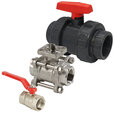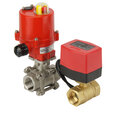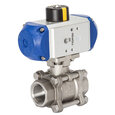A Comprehensive Guide to Ball Valves Port Designs
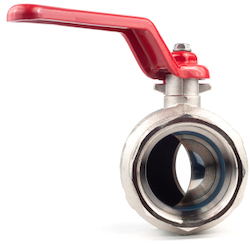
Figure 1: Ball valve
Table of contents
- Ball valves based on port size
- Comparison between full port, standard port, and reduced port ball valves
- Full port ball valve with a drain
- 3-way full port ball valve
- Comparison chart
- FAQs
View our online selection of ball valves!
Ball valves based on port size
Full port ball valve
A full port or full bore ball valve is a type of ball valve where the inlet and outlet pipes have the same diameter as the bore in the valve. In simple terms, the valve port is the same size as the pipe resulting in a full flow ball valve. For a full port ball valve, there is little or no resistance to the flow of fluids, and the flow path is straight.
Standard port ball valve
In a standard port ball valve, the size of the bore in the ball is smaller than the size of the inlet and outlet pipes. The diameter of the flow path through the ball valve is narrower on the interior. The standard port ball valve creates resistance to flow, increasing its fluid pressure. The flow path is usually straight.
Reduced port ball valve
In reduced bore ball valves, the port in the ball valve is one pipe size narrower than the inlet and outlet pipes. In other words, the diameter of the bore is one specification smaller than the pipes' diameter specification. The fluid flowing through a reduced port valve has a higher velocity.
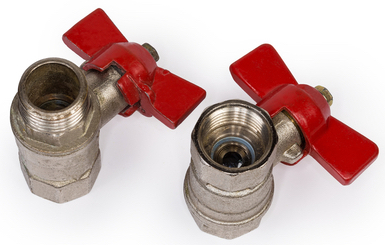
Figure 2: Full port (left) and reduced port (right) ball valves
Comparison between full port, standard port, and reduced port ball valves
As the features of reduced port and standard port ball valves are identical in all aspects both valve types are grouped into one throughout the comparison process as seen below.
Port size
- Reduced/standard port ball valves: The valve port is smaller than the pipe diameter.
- Full port ball valves: The size of the valve port is the same as that of the pipe diameter.
Media
Media is the fluid flowing through the pipes and the ball valve. The media can be solids, liquids, or gases.
- Reduced/standard port ball valves: Reduced or standard port ball valves are helpful to convey plain fluids like gasses or water. These valves transport light media in general.
- Full port ball valves: The full-bore ball valves are suitable forviscous fluids because it offers little or no flow resistance. Examples of viscous fluid include paraffin, glycerin, etc.
Pipeline and flow control
- Reduced/standard port ball valvesReduced and standard port ball valves offer a flow resistance, thus producing a pressure drop. The flow path through the valve becomes narrower on the valve’s inside. Reduced or standard port ball valves are ideal for relaxed working conditions where pressure drop does not affect pipe performance. This is because these valves reduce the velocity of the medium and hence suitable for applications where flow resistance is acceptable.
- Full port ball valves: A full port ball valve has a straight flow path and offers little or no resistance to the media flow. The flow path through a full port ball valve does not become narrower on the inside. Full-bore ball valves are the only option for piping systems under strict working conditions. Underground pipes, regardless of the medium, must only use full port ball valves. When it comes to pipeline control, full port valves are ideal.
Pigging applications
Pigging is the process of cleaning a gas pipeline where a device known as a pig travels through the pipeline. This process is not supported by certain valve types that do not allow the free travel of pig through the connected valve.
- Reduced/standard port ball valves: Reduced port ball valves have different diameters for the bore and connecting pipe; hence the pigging device cannot travel freely through a reduced bore ball valve for cleaning purposes.
- Full port ball valves: In an open state, the bore of a full-port ball valve is parallel to the inlet and outlet ports; hence, there is no visual difference between the valve and pipe bores. In this way, a pig can have an unrestricted flow through the valve, thereby cleaning the bore of the valve along with the entire pipeline.
Cost
- Reduced/standard port ball valves: A reduced or standard port ball valve has a compact body and thus lower costs.
- Full port ball valves: Purchasing a full port ball valve requires a larger initial investment than purchasing a reduced port ball valve. The full port is more expensive because many materials are used in its construction. Because of its effective performance, a full-port ball valve is cost-effective in the long run.
Fitting space
Fitting space is the amount of space the ball valve will occupy when installed.
- Reduced/standard port ball valves: A reduced/standard port ball valve has a small volume and thus requires little space.
- Full port ball valves: A full-port ball valve has a large volume necessitating more space.
Transportation
- Reduced/standard port ball valves: The small volume and lightweight properties of a reduced port ball valve make it easy to transport.
- Full port ball valves: The full-port ball valve is heavy and has a large volume. This makes its transportation difficult and costly.
Full port ball valve with a drain
A full port ball valve with a drain is essential for preventing fluid or condensation buildup inside the valve. Failure to drain the valve can damage the valve. Draining is done to replace contaminated and stale fluids within the valve. Draining relieves any pressure that has built up within the valve. To drain a ball valve, first, allow fluid to flow into the drain by opening the valve. Then, close the valve to prevent fluid from flowing through it. Finally, open the valve and allow the fluid to drain. Read our article on condensate drain valve for more information.
3-way full port ball valve
A 3-way full port ball valve has three ports. These valves are available with either an L or T-port design. The L and T designation refers to the internal bore design, determining the media's flow direction. A 3-way ball valve with a T or L port allows for mixing, distribution, or diverting the flow direction for different applications. To open a 3-way, rotate the ball until the ports are aligned with the corresponding ports, allowing fluids to flow through. To close, rotate the ball back to the closed position. When the ports are closed, they are out of place and not aligned with one another.
Comparison chart
Table 1: Comparison between standard/reduced and full port ball valve port designs
| Standard/reduced port ball valve | Full port ball valve | |
| Pipeline control | Not ideal | Ideal |
| Cost | Low initial cost | High initial most |
| Fitting space | Less | More |
| Transportation | Easy | Difficult |
| Pigging applications | Not ideal | Ideal |
FAQs
What is the difference between standard port and full port ball valves?
In a full port ball valve, the ports of the valve have the same diameter as the connecting pipes. The valve port size is smaller than the pipe diameter in a standard port ball valve.
Why is the standard port more common than the other types of ball valves?
The design of a standard port ball valve is convenient for most applications. It is compact, relatively light, and less expensive.




